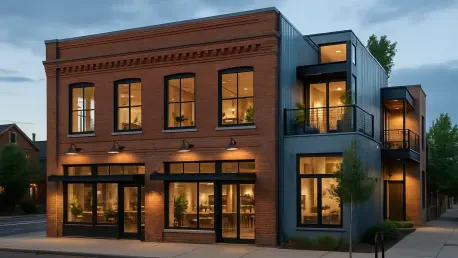As we dive into the transformation of Denver’s iconic Petroleum Building, I’m thrilled to sit down with Luca Calarailli, a seasoned expert in construction, design, and architecture. With a deep passion for innovative technology applications in the industry, Luca brings a unique perspective to adaptive reuse projects like this one. Today, we’ll explore the motivations behind converting a midcentury office tower into a vibrant residential complex, the intricate design and planning process, and how this project contributes to the broader revitalization of downtown Denver. From historic preservation to modern amenities, Luca offers insights into how such transformations can breathe new life into urban spaces.
Can you share what sparked the idea to turn the Petroleum Building into apartments rather than maintaining it as office space?
The inspiration came from a combination of market dynamics and urban needs. Downtown Denver, like many urban centers, has seen a surge in office vacancies in recent years, especially post-pandemic. At the same time, there’s a pressing demand for housing in the city core. Converting the Petroleum Building into residential units made sense as a way to repurpose an underutilized asset while addressing a critical shortage of homes. It’s about aligning with the evolving identity of downtown as a place to live, not just work.
How did the growing need for housing influence the decision to pursue this adaptive reuse project?
Housing demand was a major driver. Denver’s population continues to grow, and people want to live close to cultural hubs, amenities, and transit. The Petroleum Building’s location at 16th Street and Broadway is ideal for that. By transforming this space into apartments, we’re not just filling a gap in the market; we’re helping to create a more vibrant, 24/7 downtown where residents can live, play, and thrive without needing to commute long distances.
What can you tell us about the mix of apartment types planned for the building?
The project includes 178 market-rate rental units, with a mix of studio, one-bedroom, two-bedroom, and three-bedroom apartments. This variety was intentional to cater to a broad range of residents, from young professionals seeking smaller, efficient spaces to families needing more room. It’s about creating a diverse community within the building that reflects the eclectic nature of downtown Denver itself.
How does the building’s design aim to appeal to specific groups of residents?
While we’re not targeting one narrow demographic, the design considers the lifestyles of urban dwellers—think young professionals, creatives, and even small families who value proximity to the city’s pulse. Features like modern layouts and access to amenities are tailored to those who prioritize convenience and connectivity. We’ve thought about how different people live and worked to ensure the spaces feel inclusive and adaptable.
Can you walk us through the role of the Denver Downtown Development Authority in supporting this project?
The DDA has been a crucial partner. They’ve provided a loan commitment that helps bridge the financial gap for a project of this scale. Adaptive reuse can be costlier than new construction due to the complexities of retrofitting an older structure, so their support is vital for moving forward. It’s a sign of confidence in the project’s potential to contribute to downtown’s revival, and their involvement ensures we’re aligned with broader urban development goals.
What are the next steps to secure final funding approval for this redevelopment?
The DDA’s loan commitment needs final approval from the Denver City Council, which involves presenting the project details, financial plans, and expected community benefits. It’s a thorough process to ensure transparency and alignment with city priorities. We’re working closely with stakeholders to address any concerns and demonstrate how this conversion supports Denver’s long-term vision for a thriving downtown.
What unique features are being incorporated to make the building stand out for future residents?
We’ve planned some exciting amenities to elevate the living experience. There’s a penthouse dog park and lounge, which came from recognizing how many urban residents have pets and crave outdoor space. We’re also adding dedicated workspaces for remote workers and on-site electric car sharing to promote sustainability. These features are about enhancing quality of life and meeting modern needs in a way that feels integrated with the building’s character.
How does this project contribute to the larger goal of revitalizing downtown Denver?
This conversion is a piece of a bigger puzzle to reimagine downtown as a mixed-use, dynamic area. By turning an underused office building into housing, we’re bringing more people into the core, which supports local businesses and cultural spots. The location near Civic Center Park and other amenities adds tremendous value, making downtown a destination for living. Projects like this can inspire similar conversions, showing how adaptive reuse can tackle vacancy issues while preserving historic assets.
Can you elaborate on the design approach to preserving the building’s historic character?
Absolutely. The Petroleum Building is a midcentury gem, and our goal is to honor that heritage while making it functional for today’s residents. We’re restoring the facade to reflect its original design, emphasizing its role as a gateway to 16th Street. Inside, we’re balancing modern layouts with nods to the building’s history, ensuring that the spaces feel both timeless and fresh. It’s a delicate dance, but one that’s essential for maintaining the soul of the structure.
What is your forecast for the future of adaptive reuse projects in urban centers like Denver?
I’m optimistic about the potential for adaptive reuse to reshape cities. As office spaces continue to face challenges with vacancy rates, and housing shortages persist, projects like this will become more common. They’re a sustainable way to repurpose existing structures, reduce urban sprawl, and preserve history. In Denver specifically, I see a wave of conversions on the horizon, especially as policies and funding mechanisms evolve to support these efforts. It’s an exciting time to rethink how we use our built environment.









